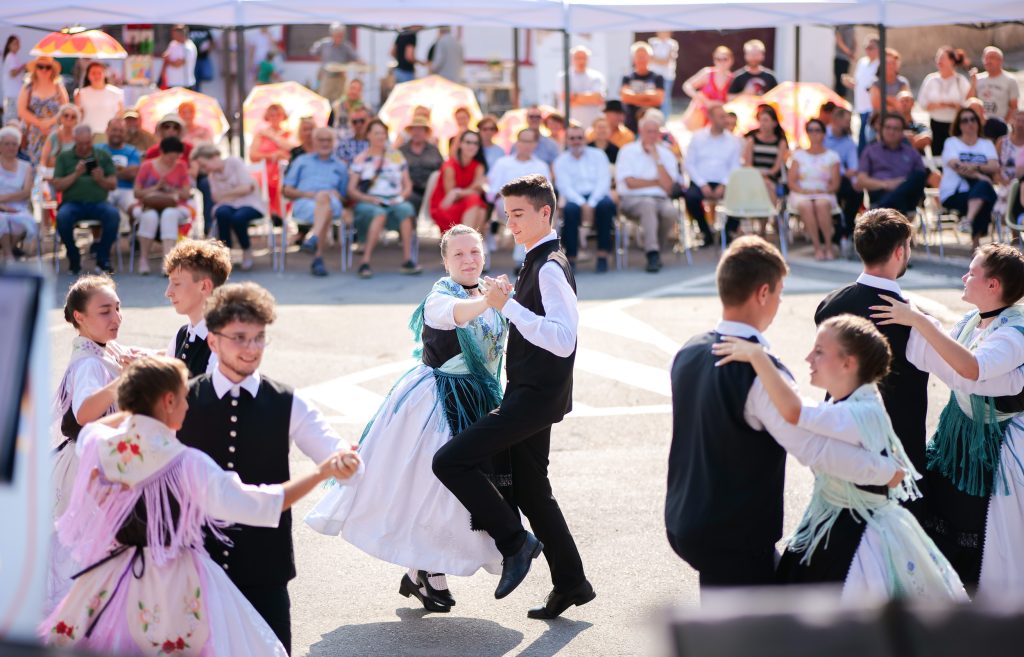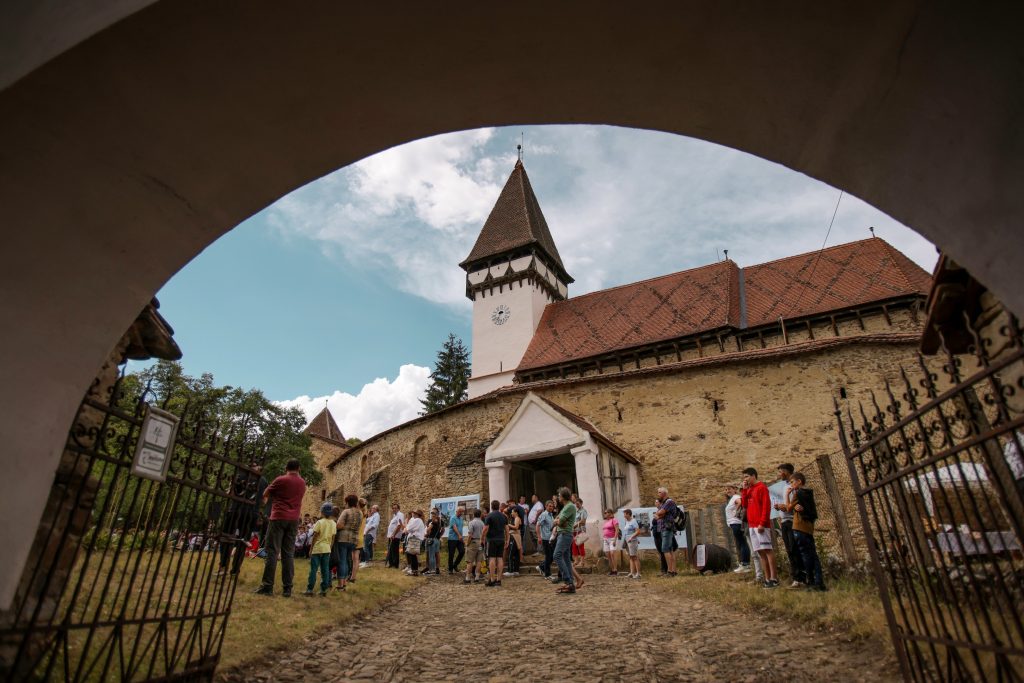:quality(80)/business-review.eu/wp-content/uploads/2023/07/Crit-30-Iul-2022-201.jpg)
Haferland Week, a celebration of Transylvanian Saxon culture, beckons us to explore the allure of local tradition, this year with a special emphasis on sustainability. Join Business Review as we venture behind the scenes to unveil the essence of this remarkable event.
The 11th edition of Haferland Week, the largest festival dedicated to the culture and traditions of Transylvanian Saxons, will take place from August 3-6 across ten villages, in the region historically known as the “Land of Oats:” Archita, Saschiz, Homorod, Rupea, Criț, Roadeș, Meșendorf, Cloașterf, Bunești, and Viscri.
This year, visitors will be able to enjoy Saxon music and organ concerts, traditional craft workshops for children and adults, traditional Saxon balls, visits to farms and traditional local homes, organic product tastings, and much more.
As part of this year’s program, visitors will have the opportunity to witness the reconsecration of the Evangelical Church (Augsburg Confession) in Rupea. This recently restored architectural ensemble includes a fortified enclosure wall, a characteristic feature of Saxon churches in Transylvania. Founded in the early 14th century, the church is one of the oldest and most impressive places of worship for the Transylvanian Saxon community in Romania.
“The Haferland villages are the living memory of a local civilisation that has thrived here for almost eight centuries, and one of the three major ethnic components that define Transylvania. They represent the essence of Saxon civilisation, with their unique mix of local architecture, crafts, food, and customs. Visitors can see and experience here a way of life that has its roots in Medieval Europe, a sort of Central European transplant into the farthest reaches of the East. Haferland is a gateway to experiencing Transylvania and its better-known sights like the Black Church in Brasov or the city of Sibiu. Uniquely, and most importantly, Haferland gives visitors the opportunity to meet a living Saxon community that has been there since the times of the Crusades,” says Michael Schmidt, the president of the M&V Schmidt Foundation, the main organiser of the event.

Read also: Michael Schmidt, M&V Schmidt Foundation: “I see Haferland Week as one more way to make possible a sustainable future for the places where I grew up, for the children and grandchildren of my generation.”
Every year, Haferland Week takes place mid-summer for a period ranging from three to seven days. Each of the villages included in the festival presents its own agenda, based on its resources and cultural specificity. The number of participants has been growing from year to year; over the ten editions held so far, the total number of visitors has exceeded 37,500.
Uncovering Transylvania’s hidden gems
In the past, there were approximately 300 fortified churches. Nowadays, nearly 160 well-preserved places of worship still mark the rural area of Transylvania, of which seven received UNESCO World Heritage status in 1993. This type of settlement has remained unchanged since the Middle Ages. All seven villages are dominated by their fortified churches, built between the 13th and 16th centuries: Viscri, Biertan, Prejmer, Calnic Citadel, Darjiu, Saschiz, and Valea Viilor.
“The biggest current problems of the Transylvanian Saxon village are the mass migration of the German ethnic population—leading to the decline of the community—and, in some places, even the complete disappearance of the local community. The remaining issues are related to the preservation and conservation of our ecclesiastical and cultural heritage, the preservation of houses, and the ongoing depopulation of these places, which hinders their sustainable development,” comments Dean Dr Daniel Zikeli, Vicar Bishop at the Evangelical Church A.C. of Romania.
Organisations like the Fortified Churches Foundation are preserving this unique heritage by developing adaptive reuse projects. As they primarily deal with rural monuments, traditional reuse models like libraries or community centres are not feasible. Instead, these buildings are turned into accommodation units, offering simple stays with holistic heritage experiences for culture-interested tourists visiting the fortified churches.
The Mihai Eminescu Trust is doing something similar, having been preserving Romania’s cultural and material heritage since the 1980s. In the first decade after the fall of the communist regime, their focus gradually turned to the preservation of villages in the south-eastern part of Transylvania, where they have been working ever since to help revitalise those communities.
“Over the past 23 years, our team has supervised around 1,300 different projects involving at least 115 villages and several cities in Transylvania. (…) We’ve also planted more than 3 million trees, trained a couple hundred locals in traditional crafts, refurbished private homes, manors, and Medieval churches, sometimes teaching the owners themselves how to do restoration work, assisted in archaeological digs, taught business and English to locals, carried out projects together with schools, town halls, and the forestry service, and so on,” explains Caroline Fernolend, president of the Mihai Eminescu Trust.
In this ever-changing world, a ray of hope shines through. “In recent years, more and more Evangelical churches have been restored, consolidated, and put back into use. Around 65 out of the 240 extant churches have been restored with European funding, self-funding, with the support of local authorities, or through various associations and foundations. Others will follow. Unfortunately, about 5 churches are in an advanced state of decay and in danger of collapsing, especially in those places where there is no longer an Evangelical community or other means of supporting these buildings,” adds Dean Dr Daniel Zikeli.

The theme of Haferland Week 2023: Sustainability
Delving into the realm of sustainability within rural environments can prove to be a significant challenge, particularly when confronted with the enduring presence of heritage structures that have stood the test of time for over three centuries. Curiosity piqued, Business Review embarked on a quest to understand the personal perspectives of the event organisers and their partners regarding this multifaceted concept of sustainability.
“The festival must look both to the past and to the future. I would add that Haferland Week has come to be defined by its rather small footprint and tradition-oriented agenda, so any changes would have to build on that aspect. The first half of the equation, the side facing the past, is the simplest to deal with. I’m clearly aware that the thriving Saxon community I grew up in is gone forever; there are too few Saxons of my generation left. But my ancestors’ way of life, their traditions, songs, food, their homes, and their churches can definitely be saved from oblivion. It’s a matter of making sure the Saxons have a place they can call home here, even as this place now welcomes young affluent ethnic Romanians and foreigners who are drawn by the magic of these places. Many of these young people love these places precisely for what they mean, for their history and cultural heritage,” argues Michael Schmidt.
Since 2013, Haferland Week has addressed a different theme related to culture or education at each annual edition: The Year of Music (2013), The Year of Restoration (2014), The Year of Education (2015), The Year of the Family (2016), The Year of Gastronomy (2017), The Year of Saxon Crafts (2018), The Year of Community (2019), the first online edition of the festival (2020), The Year of Tradition (2021), and the promotion of intercultural education and environmental conservation (2022).
“There’s a phrase that says there is no future without the past. It’s very important to me to be able to help the people here build a life using local resources: teaching them traditional crafts or helping them start small businesses to secure a steady income. This is why we are also involved in creating jobs and developing entrepreneurial capability at a local level, for example by providing business skills or handicraft training,” Caroline Fernolend adds.



:quality(80)/business-review.eu/wp-content/uploads/2024/07/VGP-Park-Timisoara_-8thbuilding_iulie-24.jpg)



:quality(80)/business-review.eu/wp-content/uploads/2024/06/22C0420_006.jpg)

:quality(80)/business-review.eu/wp-content/uploads/2024/06/COVER-1-4.jpg)



:quality(50)/business-review.eu/wp-content/uploads/2023/07/Caroline-Fernolend-Presedinte-Fundatia-Mihai-Eminescu-Trust-scaled.jpg)
:quality(50)/business-review.eu/wp-content/uploads/2023/07/Screenshot-2023-07-24-at-1.05.15-PM.png)
:quality(80)/business-review.eu/wp-content/uploads/2024/06/br-june-2.jpg)
:quality(50)/business-review.eu/wp-content/uploads/2024/07/America-House-Offices-Bucharest-Fortim-Trusted-Advisors.jpg)
:quality(50)/business-review.eu/wp-content/uploads/2024/07/BeFunky-collage-33-scaled.jpg)
:quality(50)/business-review.eu/wp-content/uploads/2024/07/BeFunky-collage-32-scaled.jpg)